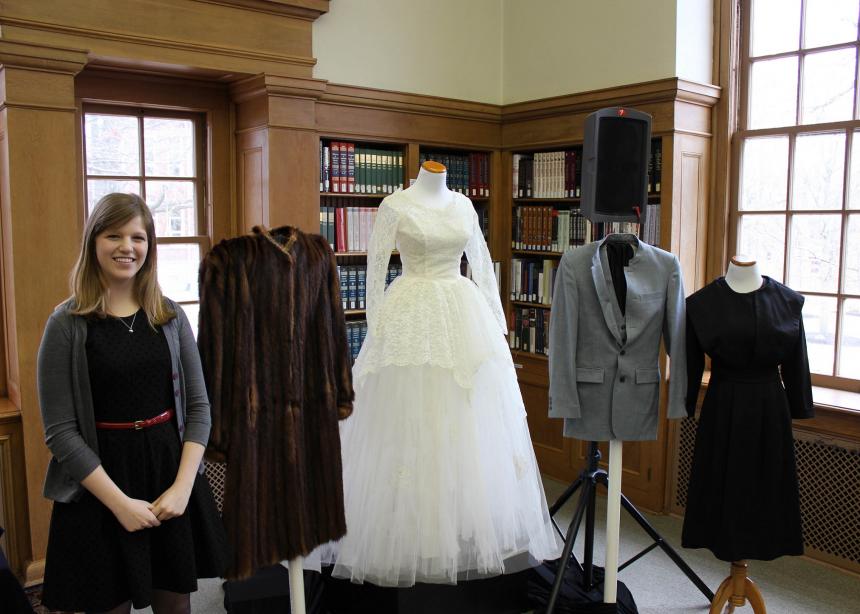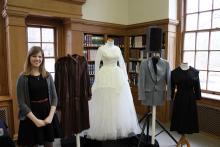From plain coats to lace-covered wedding dresses, Amanda Bartel, a history major from Iowa City, Iowa, is cataloging Bluffton University’s historic clothing collection to learn more about what it means to dress like a Mennonite. She explained the cataloging process for students, faculty, staff and community members on March 1, 2016, at Bluffton University.
The collection is currently stored in Berky Hall at Bluffton University and was originally used by students in the fashion design major that is no longer offered.
“I think the most fun I had with this project was just the mystery of everything,” said Bartel. “While a good section of the collection is somewhat known, there is a large amount that is not. “So, [the clothes] are just hanging around waiting for us to figure them out.”
Bartel explained, however, that she is using things like labels, design points, construction techniques and fabrics to determine approximate ages for the items. “This process can take anywhere from ten minutes to two hours or two days.”
The major lesson Bartel learned from the project was the importance of documentation.
“Because of the lack of paperwork, we have lost the information on the object, including what is probably the most important part, which is the provenance.”
Provenance is the story of where an object came from. “With the loss of provenance, you can’t really tell its story,” said Bartel.
On display during Bartel’s presentation were five items from the collection, including a pair of shoes she stumbled across stored in a hatbox. The shoes ended up being one of the few objects in the collection that has a clear provenance. Included in the hatbox was a note which read, “Wedding shoes of Ida Boyer Marshall married to John R. Marshall, December 24, 1874.”
Bartel also displayed a lace-covered wedding dress which reminds her of the wedding dress worn by her grandmother in 1958. “This dress seems to have very similar features, so this is an example of how we can estimated the date of objects.”
The collection also includes a rack of fur coats. Based on tags found inside the coat, Bartel believes the one she displayed is made of beaver fur and was sold in Lima.
She also included two examples of plain clothes: a cape dress and a plain coat. The plain coat also has a clear provenance, as it was part of a baptismal suit worn by Dr. Gerald Mast, Bluffton University professor of communication, when he was 16.
Bartel developed the skills for cataloging the collection as the archives assistant in the Musselman Library and through several internships, including stints at the Herbert Hoover Presidential Library, the Smithsonian Anacostia Community Museum, and the Smithsonian National Portrait Gallery.
Besides cataloging, Bartel is also improving the storing and packaging of the clothes. She used guidelines put forward by the Smithsonian Institution on what types of materials should be stored, how they should be stored, and what materials are best to store them with.
The goal of the project is to simulate the job of a museum’s collection manager—Bartel’s dream job. Upon graduation, she will pursue a master’s degree in museum studies at Johns Hopkins University.



Add new comment
Canadian Mennonite invites comments and encourages constructive discussion about our content. Actual full names (first and last) are required. Comments are moderated and may be edited. They will not appear online until approved and will be posted during business hours. Some comments may be reproduced in print.